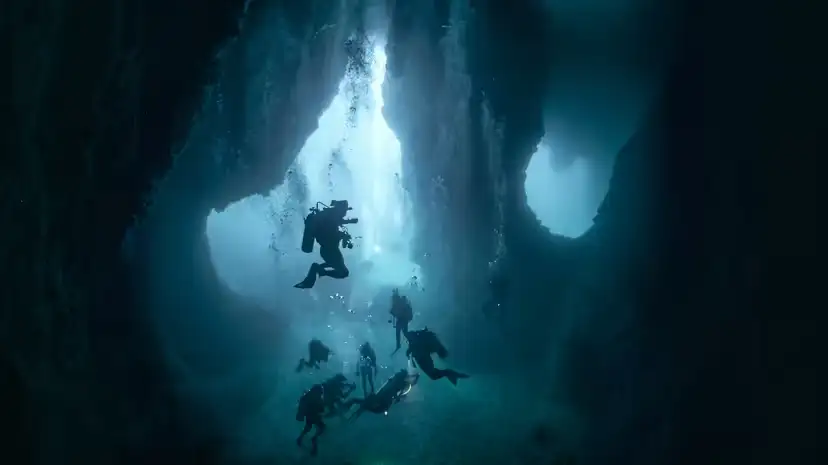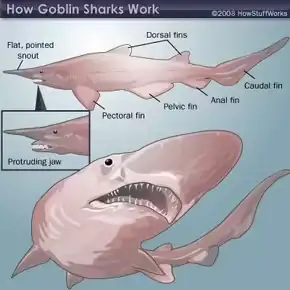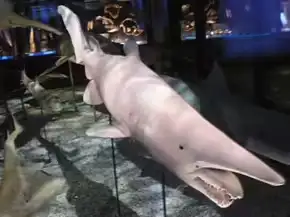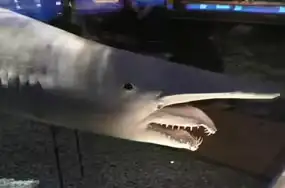The goblin shark is one of the ocean’s strangest predators. With a blade-like, elongated snout, semi-translucent pink skin, and a protrusible, slingshot-style jaw, it looks like it swam out of a sci-fi movie. Yet each of these odd traits is a razor-sharp adaptation to life in the deep sea.

You have to go really, really deep to even have a chance at spotting a goblin shark in its natural habitat.
Common names: Goblin shark, “elfin shark”
Scientific name: Mitsukurina owstoni (family Mitsukurinidae)
Typical habitat: continental slopes and seamounts, benthopelagic zone
Usual depth: commonly a few hundred to over a thousand meters (can be deeper)
Conservation: IUCN currently lists the species as Least Concern (data still limited)
The face is the showstopper: a long, flattened rostrum packed with electroreceptors and a jaw that can launch forward to seize prey. Needle-like, recurved teeth help pin slippery fish and squid. The body is relatively soft and flabby—typical of deep-sea species that favor low-energy cruising over bursts of speed. Its pinkish color isn’t pigment; it’s blood vessels visible through thin skin in low light.
Key features at a glance
Elongated rostrum (snout): studded with ampullae of Lorenzini for electroreception.
Protrusible “slingshot” jaws: double-ligament system lets the jaws shoot forward in a split second.
Recurved, needle-like teeth: ideal for grasping soft-bodied prey.
Translucent pink skin & soft body: classic deep-sea, low-metabolism design.

Goblin shark body structure
Mitukarina owstoni belongs to Mitsukurinidae, a lineage traceable back to the early Cretaceous (~120+ million years). Fossil relatives (e.g., Scapanorhynchus) show strikingly similar cranial and jaw traits, suggesting the goblin shark’s core design has remained stable for eons. In other words, the blueprint works so well in its niche that little overhaul was needed.
The goblin shark’s liver is massive and rich in low-density oils (e.g., squalene). That makes the shark’s overall density close to seawater, so it can hover and glide with minimal fin strokes. Less motion means less noise and wake, allowing the shark to float within striking distance before the jaw rockets forward to clinch the catch. Pair that with the snout’s electrical “radar,” and you get a stealth-first hunting toolkit:
Electroreception → Silent approach (oil-rich liver) → Slingshot strike.

A life-size model of the rare goblin shark at the Natural History Museum in Vienna, Austria.
Diet records point to mid-sized fishes, cephalopods (squid and small cuttlefish), and crustaceans. Like many deep-sea specimens, captured individuals often have empty stomachs—either due to regurgitation during capture or fast digestion—so researchers combine hard-part remains, trace DNA, and deep-camera observations to rebuild the menu.
The species is widely but sparsely distributed in deep waters, most often along continental slopes and around submarine canyons and seamounts. Reliable records include waters off Japan, Taiwan, Portugal and the eastern Atlantic, the Gulf of Mexico, and off California. Depth use is variable by region and life stage, but it is solidly a benthopelagic denizen.

Goblin sharks are often called the ugliest shark species because of their elongated snouts.
Goblin sharks are believed to be aplacental viviparous (embryos develop from yolk without a placental connection). Litter size appears small; rare records include a pregnant female with six embryos. Growth is slow, maturity is late, and lifespan is long for a shark—roughly 30–60 years based on limited aging studies. Much remains to be confirmed because encounters are rare.
Human risk: effectively none—they live far offshore and far below recreational depths.
Fishery value: little to none; most records are bycatch in deep-water longline or trawl fisheries.
Conservation: listed as Least Concern, but scientists emphasize data limitations and potential local vulnerability from deep-sea fishing and future seabed activities. Monitoring bycatch and protecting vulnerable deep-sea habitats are prudent.
How long do goblin sharks live?
Estimates range from 30 to 60 years. Sparse samples and the difficulty of aging deep-sea sharks make precise figures challenging.
Where are goblin sharks most often found?
They are globally scattered in deep waters with more reports from Japan and the western Pacific, plus records from the Atlantic, Gulf of Mexico, and the eastern Pacific (e.g., off California).
Do goblin sharks attack humans?
No. Their habitat is hundreds to thousands of meters deep, well beyond normal human activity.
Can aquariums keep goblin sharks?
Essentially no. The combination of pressure, temperature, and light requirements makes long-term husbandry impractical; past attempts have survived only briefly.
Why are many captured goblin sharks “empty-stomached”?
Deep-sea fishes often regurgitate under capture stress or digest quickly; an empty stomach doesn’t mean the shark isn’t feeding.
Sources
Bright, Michael. "The Private Life of the Sharks: The Truth Behind the Myth." Stackpole Books. 2000. (May 14, 2008)http://books.google.com/books?id=w31fF5IlqdoC
Carwadine, Mark. "Shark." Firefly Books. 2004. (May 14, 2008)http://books.google.com/books?id=Qh44RNa5yh0C
Ebert, David A. "Sharks, Rays and Chimaeras of California." University of California Press. 2003. (May 14, 2008)http://books.google.com/books?id=1SjtuAs702kC
Food and Agriculture Organization of the United Nations. "Mitsukurina owstoni." Fisheries and Aquaculture Department. 2001. (May 14, 2008)http://www.fao.org/fishery/species/13494
Jordan, Vanessa. "Goblin Shark." Florida Museum of Natural History Ichthyology Department. (May 14, 2008)http://www.flmnh.ufl.edu/FISH/Gallery/Descript/GoblinShark/GoblinShark.html
Krock, Lexi. "Other Fish in the Sea." NOVA Online. January 2003. (May 14, 2008)http://www.pbs.org/wgbh/nova/fish/other.html
Mehta, Aalok. "Rare 'Prehistoric' Goblin Shark Caught in Japan." National Geographic. Feb. 9, 2007. (May 14, 2008)http://news.nationalgeographic.com/news/2007/02/070209-goblin-shark.html
ReefQuest Centre for Shark Research. "Biology of the Goblin Shark." Biology of Sharks and Rays. (May 14, 2008)http://elasmo-research.org/education/shark_profiles/m_owstoni.htm
Yano, Kazunari; Miya, Masaki; Aizawa, Masahiro; Noichi, Tetsuhisa. "Some aspects of the biology of the goblin shark, Mitsukurina owstoni, collected from the Tokyo Submarine Canyon and adjacent waters, Japan." Ichthyological Research. May 22, 2007. (May 14, 2008)http://www.springerlink.com/content/p430623g30188246/fulltext.pdf
animal tags: goblin shark
We created this article in conjunction with AI technology, then made sure it was fact-checked and edited by a Animals Top editor.